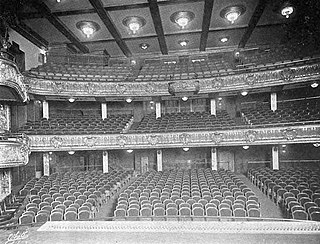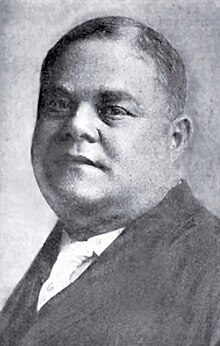
George Lee"Sparky"Anderson was an American Major League Baseball (MLB) player, coach, and manager. He managed the National League's Cincinnati Reds to the 1975 and 1976 championships, then added a third title in 1984 with the Detroit Tigers of the American League. Anderson was the first manager to win the World Series in both leagues. His 2,194 career wins are the sixth-most for a manager in Major League history. His 1,331 wins with the Tigers are the most for any manager in team history. Anderson was named American League Manager of the Year in 1984 and 1987. He was elected to the Baseball Hall of Fame in 2000.

Leila Marie Koerber, known by her stage name Marie Dressler, was a Canadian stage and screen actress, comedian, and early silent film and Depression-era film star.

The Cincinnati Enquirer is a morning daily newspaper published by Gannett in Cincinnati, Ohio, United States.

Abraham Lincoln Erlanger was an American theatrical producer, director, designer, theater owner, and a leading figure of the Theatrical Syndicate.

Walnut Hills High School is a public college-preparatory high school in Cincinnati, Ohio. Operated by Cincinnati Public Schools, it houses grades seven through twelve. The school was established in 1895 and has occupied its current building since 1932.

Patrick Joseph Moran was an American professional baseball player and manager. He was a catcher in Major League Baseball from 1901 to 1914. The year after his retirement, he became a manager, and he led two teams to their first-ever modern-era National League championships: the 1915 Philadelphia Phillies and the 1919 Cincinnati Reds. Moran was the first manager to win National League pennants with two different teams. Moran's 1919 Reds also captured their first World Series championship.

Gilbert Heron Miller was an American theatrical producer.

Benjamin Franklin Keith was an American vaudeville theater owner, who played an important role in the evolution of variety theater into vaudeville.

George Joseph Edwardes was an English theatre manager and producer of Irish ancestry who brought a new era in musical theatre to the British stage and beyond.

George Grossmith Jr. was an English actor, theatre producer and manager, director, playwright and songwriter, best remembered for his work in and with Edwardian musical comedies. Grossmith was also an important innovator in bringing "cabaret" and "revues" to the London stage. Born in London, he took his first role on the musical stage at the age of 18 in Haste to the Wedding (1892), a West End collaboration between his famous songwriter and actor father and W. S. Gilbert.

George Michael Cohan was an American entertainer, playwright, composer, lyricist, actor, singer, dancer and theatrical producer.

The Gaiety Theatre was a Broadway theatre at 1547 Broadway in Times Square, Manhattan, New York City from 1909 until 1982, when it was torn down.

Louis Langrée is a French conductor. He is the son of organist and theorist Alain Langrée.

Henry Bracy was a Welsh opera tenor, stage director and opera producer who is best remembered as the creator of the role of Prince Hilarion in the Gilbert and Sullivan comic opera Princess Ida. Bracy often played the leading tenor role in the works in which he appeared, becoming one of the most popular comic tenors of the Victorian era. His wife, Clara, was an actress.

George W. Keister was an American architect. His work includes the Hotel Gerard (1893), the Astor Theatre (1906), the Belasco Theatre (1907), the Bronx Opera House (1913), the Apollo Theater in Harlem (1914), the Selwyn Theatre, and the First Baptist Church in the City of New York. He also designed Woodbridge Hall at 431 Riverside Drive (1901), which faced demolition in 1996, and the Sigma Chi Fraternity at 565 W. 113th St. (1903).

The Bronx Opera House is a former theater, part of the Subway Circuit, now converted into a boutique hotel in the Melrose neighborhood of the Bronx, New York City. It was designed by George M. Keister and built in 1913 at 436 East 149th Street on the site of Frederick Schnaufer's stable. It was one of several theaters to come into the area that became known as the Hub. It was formally dedicated on opening night Saturday, August 30, 1913.

Kathryn Osterman was an American comic vaudeville actress on stage and in silent films.

George M. Cohan's Theatre was a Broadway theatre at Broadway and West 43rd Street in the Midtown Manhattan neighborhood of New York City. It was built in 1911 and demolished in 1938.

Helen Lackaye was an American actress.

Caroline Madeline Gardner, better known by her stage name Carrie Swain, was an American actress, acrobat, and singer. One of the first female acrobats and belting vocalists to appear in vaudeville, she began her career performing in variety and minstrel shows during the 1870s. She first rose to national prominence in the early 1880s, touring in the musical The Tourists of the Palace Car. In 1882 she created the role of Topsy in composer Caryl Florio and dramatist H. Wayne Ellis's musical adaptation of Uncle Tom's Cabin, and then toured nationally in several plays written for her, among them Leonard Grover's Cad, the Tomboy and Frederick G. Maeder's Mat, the Romp.





















